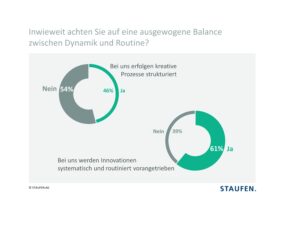
For 54 percent of German businesses, the creative process is still very much unstructured. These are the results of the “Success in Transformation” study carried out by Staufen Consultancy. As a part of the study, more than 650 top management executives of German companies were surveyed. Putting your faith in creative chaos has its consequences: Unnecessarily long development times and high costs. Market analysis shows, with structured development processes more new products reach market maturity faster.
A substantial majority – 61 percent – indicated that they systematically and routinely promote innovations. And yet, without clear-cut processes, approaches such as these cannot reach their potential and largely evade evaluation – making continuous improvement impossible.
The fact that, despite the commitment to use systematic strategies, structured processes are followed with relative infrequency, can be attributed to an inherent distrust of creative minds: Whereas, for the most part, clearly defined processes are well-established and valued in other areas of a company, research, development, and other departments dealing with innovations often lag far behind. The guiding principle: creative thinking and innovative capacity should not be boxed in. “Employees and managers in creative departments are often worried that well-defined processes will take away the freedom that is paramount to new ideas and innovations. However, the opposite is true: Through lean innovation and lean development, developers gain more headroom for the truly important tasks,” declares Staufen expert Dr. Andreas Romberg.
On the other hand, a lack of structure and complicated processes can result in substantial problems in research and development. Without seamless processes, actual routine processes unnecessarily consume the time and resources needed for truly crucial tasks. Mistakes in the development process, which go undetected in creative chaos, lead to substantial additional expenses and effort on the part of additionally required capacity, should they have to be eliminated later in the project cycle. Most recently, the digital transformation has introduced a sense of urgency. “On the one hand, digitally driven innovation cycles are significantly faster, which increases the pressure on development departments to be competitive. On the other hand, numerous new approaches, such as the digital twin and the virtual machine, can only be implemented if the respective physical processes are also running smoothly,” warns Romberg.
The fact that German industrial companies face an ongoing and challenging task is evidenced by the study: at least two thirds profess their capacity for innovation. Almost as many see themselves as learning organizations equipped for continuous improvements and systematic problem solving. The feat now lies in transferring this self-image and lean competency, very much present in production and logistics, to the fields of research and development.
About the “Success in Transformation” study
For the “Change Readiness Index 2017”, Staufen Consultancy surveyed a total of 658 companies in Germany on the topic of “Success in Transformation” in the spring of 2017. More than 60 percent of the companies surveyed are in the mechanical and plant engineering, electronics and automobile industries.

